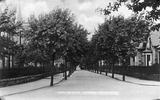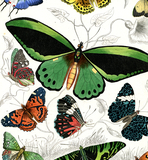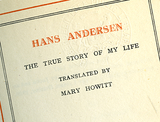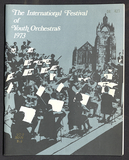|
Quick Search
|
Search Results
You searched for: More Like: 'Treasure 41: Mary Garden Record Collection'
11 items
items as
Treasure 6: Royal Horticultural Society of Aberdeen
2275 Enthusiastic gardeners who have spent months, if not years, nurturing their plants have the opportunity to display their efforts at flower shows - usually held in August or September. These events for individuals happen all around the country and have a long history.
Britain in Bloom is the national flower show for whole communities. It was the brainchild of Roy Hay, a horticultural journalist. Following a holiday in France where he admired the "Fleurissement de France", he persuaded the British Travel and Holidays Association (later the British Tourist Authority) to organise a similar competition for communities in Britain.
Although the first competition in 1964 was won by Bath, Aberdeen received a "Special Mention". The city did even better in 1965 when it won the National Trophy. Although it did not win again until 1969, the city then continued its success each year until 1971. However, this achievement led to Aberdeen being debarred from the National Competition in 1972 although it still won the Scottish section. 1973 and 1974 saw Aberdeen winning the National award again, and its record 10th win was in 1998.
A slogan competition was held for the 1968 campaign when the winning entry proclaimed "Aberdeen - Garden City by the Sea".
In order to celebrate Britain in Bloom and Aberdeen's success in the competition we have chosen to highlight our collection of historic prize schedules for the Royal Horticultural Society of Aberdeen's annual exhibition.
The Aberdeenshire Horticultural Society was founded in March 1824 when a meeting of "Practical Gardeners" was held in the New Inn for the "purpose of forming themselves into a Society". The Earl of Aberdeen graciously agreed to be Patron of the Society.
In November 1863, it was announced at the annual general meeting that HRH the Prince of Wales had now agreed to become Patron of the Society and that the Society's name was to be changed to the Royal Horticultural Society of Aberdeen.
The Society's "Prize Schedule for Exhibition" gives details of each of the classes which can be entered, with the prizes which can be won - a sum of money or a cup or medal. In 1920, there were a total of 222 classes and those who exhibited were split into one of four Divisions - professional gardeners; nurserymen and florists; amateurs and working class.
The Schedules also contain the Rules of Competition, the Constitution of the Society and a list of Subscriptions and Donations received - these include names, addresses and amounts given. Our earliest copies of the booklets cover the period 1920 - 1937, although the file is incomplete.
The Society celebrated its 175th anniversary in 1999. To take a closer look at these, and many other Aberdeen historic documents, visit Aberdeen Central Library. Treasure 33: The Pedigree of the Cruickshanks of Stracathro
2321 Among the Local Studies collection of family trees is a chart from 1847 entitled Pedigree of the Cruickshanks of Stracathro. The title initially referred to the Cruickshanks of Langley Park but this has been scored out and replaced with Stracathro. A pedigree is a form of genealogical table. Collections of pedigrees were first made in the 15th century and, according to The Oxford Companion, were "a matter of aristocratic pride and of practical necessity for legal purposes". The term pedigree comes from the French 'pied de grue', meaning crane's foot, due to the resemblance of the genealogical lines to the thin legs and feet of the bird.
The pedigree of the Cruickshanks was compiled by E. G. G. Cruickshank, who features in the 10th generation detailed on the table.
The pedigree begins with the earliest ancestor at the top of the document with lines dropping down to succeeding generations. Each generation is given a Roman numeral and individuals within each generation are assigned Arabic numbers. The pedigree begins with "John Cruickshank first in Strathspey m. Mary Cumming of Elgin" and extends down to an incomplete 12th generation. The individuals in the 11th generation were mostly born in the 1870s.
The information listed on a family tree is dependent on the sources available and the purpose for which it was created. The information given on the Cruickshank's pedigree varies but typically includes an individual's date of birth, marriage details and date of death. Additional information is also supplied as is the case with the 7th generation of Cruickshanks - Margaret Helen is described as the daughter of Rev. Gerard of Aberdeen, author of a book whose title is unreadable, and sister to a Colonel Gerald. Details of army service are supplied for some individuals and many of the Cruickshanks were involved in the administration of India or served in the army there.
The tiny handwriting, use of abbreviations and sparse punctuation makes the document challenging to read so familiarity with the subject matter and names of places is useful. A later interpreter of the document has made a number of annotations in pencil. For example, one of the later additions points to an individual and reads "Is this W. Robertson of Auchinroath? Yes!"
In addition to a listing of descendants the pedigree is annotated with a number of original notes and a description of a coat of arms. The latin motto of Cavendo tutus translates as 'Safe through caution'. One note, quoting "an old paper", describes from where the family came prior to being in Strathspey. A note on the other side of the chart states that "distinguished Officer and Author the late Colonel Stewart of Garth" links the family to the Royal Family of Stewart and suggests the name of Cruickshank derives from "some deformity in the first cadet of the house."
Attached to the document is a letter dated 23 October 1927 from a Jim Bulloch to City Librarian G. M. Fraser. Bulloch explains that he got the pedigree from a Mr. Mackintosh of Elgin, thinks it is quite rare and that the library might like it for its collection. It has stayed in the Local Studies collection to this day.
The Gazetteer for Scotland website states that in 1775 Patrick Cruickshank, listed at No. 11 of the 7th generation, bought the estate of Stracathro in Angus. The property was subsequently inherited by his brother Alexander Cruickshank (1764 - 1846). Alexander hired the Aberdeen architect Archibald Simpson to build Stracathro House between 1824 and 1827. The Palladian Scottish country house still exists today.
University College London's Legacies of British Slave-ownership website indicates that Patrick and Alexander, and two other Cruickshank brothers, owned plantations on the Caribbean island of St Vincent that used slave labour. See Alexander Cruickshank's entry in the database here: 'Alexander Cruikshank of Stracathro', Legacies of British Slave-ownership database, http://wwwdepts-live.ucl.ac.uk/lbs/person/view/8590 [accessed 9th June 2020]. In 1833 when Britain abolished the ownership of slaves the government granted £20 million in compensation to former slave-owners. Alexander Cruickshank made three claims for compensation, two of which were successful.
In 1874, Stracathro House and estate were sold to Sir James Bannerman, Lord Provost of Glasgow, and father of Prime Minister Sir Henry Campbell-Bannerman. The country house was later used as a World War II hospital and owned by Tay Health Board before being sold to private owners in 2003. Hamilton Place, Looking West
2732 A postcard of Hamilton Place likely dating from the early 20th century. The view looks west from the juntion with Westfield Road. The house on the left foreground appears to be 8 Hamilton Place. A small part of 3 Hamilton Place can be seen across the road.
Correspondent Urlan Wannop, a former resident at 41 Hamilton Place, shared his memories about this place:
"My family lived in Hamilton Place between 1935 and 1948. The trees have since been removed, but on warm summer evenings we played ball games in the street before cars became prevalent. The trees stood in for stumps for games of cricket. In wartime, snow clearance for the very few motor cars and steam powered coal delivery wagons meant walls of snow at the pavement edge. I still have weights cast from lead left when all garden railings were removed in an abortive attempt to build tanks and ships for the war effort. (...)
[The] photograph precedes the wartime removal of railings. For historical record, the photograph was possibly taken in the 1920's, judging by the motor car in the background, the presence of the railings and the trees being less fully grown than in the days when they stood in as wickets for street games of cricket.
No sign of the knife grinders, bicycles of visiting French onion sellers nor of the street singer that progressed down Hamilton Place. All disappeared except from my memory.
The wartime Lord Provost, Tommy Mitchell - of Mitchell and Muil, the bakers - lived in a house at the near left; my Headmaster at the Grammar School, JJ Robertson, lived in one at the near right. Like me, he would walk to school down Craigie Loanings". Winter in Gairnshiel
4227 A photograph looking south west from the Old Military Road on the slopes of the Little Craig hill.
Beyond an icy River Gairn, in the middle distance, can be seen Gairnshiel Lodge, partially obscured by trees, and Rinloam further on.
Aberdeenshire's Historic Environment Record website describes Gairnshiel Lodge as a former hunting lodge originally built in 1746 by the Garden family.
The image shows the glen deep in winter.
This image likely dates from the 1970s or 80s. It is a part of a collection of slides donated to Aberdeen City Libraries by Aberdeen City Council's Publicity department. Treasure 2: The Edinburgh Journal of Natural History and the Physical Sciences
169 In the library's historic reference collection we have a slim bound volume of 'The Edinburgh Journal of Natural History and the Physical Sciences'.
The journal is credited as being "conducted by Captain Captain Thomas Brown, F.L.S. M.W.S. M.K.S., President of the Royal Physical Society" with the assistance of "eminent scientific and literary men."
The collected issues date from the 1830s and include articles on all manner of scientific topics of the day such as "the chemical composition of native gold" and "porcupine men".
One of the most striking features of the volume is the beautifully illustrated zoological plates that accompanied each issue.
We have chosen to highlight a colourful plate of lepidopterans engraved by James Mayson in order to celebrate the wonderful butterfly book sculpture visiting Aberdeen Central Library throughout July as part of the 'Butterflies on the Move' national tour.
To view more of the zoological plates please download the PDF file located in the Document section of this record or come see the volume displayed in the library throughout July 2015. Treasure 29: The Snow Queen and Hans Christian Andersen
202 Hans Christian Andersen wrote 'The Snow Queen' in 1844. Aberdeen City Libraries hold a number of interesting resources relating to the author. Perhaps the most notable is a 1926 reprint of his autobiography 'The True Story of My Life' translated by Mary Howitt and published by George Routledge & Sons.
Born in Odense, Denmark in 1805, Andersen wrote three autobiographies during his lifetime. 'The Book of My Life', written in 1832 aged 27, was for close friends, the Collin family, and was not intended for publication. 'The True Story of My Life' in 1846 was to accompany a German edition of his collected works and his final autobiography, 'The Fairy Tale of My Life', was published in 1855.
Mary Howitt (1799-1888) was an English author who came to prominence as a translator of Scandinavian literature, in particular eighteen volumes of the Swedish novelist Frederika Bremer (1842-1863) and many translations of Hans Christian Andersen. In the 1926 preface to 'The True Story of My Life' Scottish author and poet, Violet Jacob, claims that Howitt's "precise and innocence English" is the ideal vehicle for conveying Andersen's writing. It was through Howitt's translations that the English speaking world first came to know Andersen's work.
Howitt dedicates her translation of 'The True Story of My Life' to the Swedish opera singer Jenny Lind (1820-1887). Lind was world famous for her immaculate voice, generosity and strong religious convictions. She and Andersen were good friends. When Lind rejected Andersen as a suitor she became the model for the Snow Queen with a heart of ice. Their friendship endured nonetheless and in 'The True Story of My Life' Andersen explains the central influence Lind had on his work: "Through Jenny Lind I first became sensible of the holiness there is in art; through her I learned that one must forget oneself in the service of the Supreme. No books, no men have had a better or a more ennobling influence on me as the poet, than Jenny Lind, and I therefore have spoken of her so long and so warmly here."
The autobiography also contains other glimpses into the inspiration behind 'The Snow Queen'. For example, Andersen's childhood surroundings are said to have inspired the roof top garden on which the story's heroes, Gerda and Kai, first meet and become friends: "Our little room, which was almost filled with the shoemaker's bench, the bed, and my crib, was the abode of my childhood; the walls, however, were covered with pictures, and over the work-bench was a cupboard containing books and songs; the little kitchen was full of shining plates and metal pans, and by means of a ladder it was possible to go out on the roof, where, in the gutters between and the neighbour's house, there stood a great chest filled with soil, my mother's sole garden, and where she grew her vegetables. In my story of the Snow Queen that garden still blooms." Treasure 42: Marischal College Ground floor Architectural Plan by Archibald Simpson
211 The highly-respected architect Archibald Simpson (1790 - 1847) designed many of our city's well-known landmarks and, along with architect John Smith (1781-1852), is widely regarded as transforming Aberdeen into the Granite City in the 19th Century.
At Aberdeen City Libraries, we hold a collection of Archibald Simpson's architectural plans. Many of the originals were destroyed by a fire in his house in 1826 but the copies we hold demonstrate his initial thoughts and first sketches of some of Aberdeen's most famous buildings.
An architectural plan is usually a drawing or a sketch used by an architect to develop a design idea. The document also includes a scale and precise measurements.
Marischal College, as it stands today, was designed by Simpson in the 19th Century and this image shows a floor plan he drew when working on the project in the 1820s.
The plan depicts the ground floor which occupied three sides of a courtyard opening towards Broad Street. The building proposed by Archibald Simpson formed a U-shaped quadrangle with symmetrical rooms. The exterior granite façade, the second largest granite faced construction in the world and enclosing the quadrangle, was built by Alexander Marshall Mackenzie between 1893 and 1905 which is why it is not represented on the plan. Originally, the entrance to the courtyard was by Guild's College gateway.
Tiny lines were drawn to represent the walls between each room and the often curving stairways can be clearly seen. The rooms dedicated to classes of divinity, mathematics, moral philosophy or Greek and Latin were constructed like semi-circular amphitheatres. To the top of the plan, we can see classrooms connected by the science department, including the Anatomical Museum and Dissecting Rooms.
The building contained sixteen classrooms in addition to lodgings for porters and sacrists, the museum, the chemical laboratory and rooms for the professors. Other sources from the period suggest that the public hall, the museum and the library were spacious and magnificent rooms.
The small entrance via an archway, called 'Vestibule' on the plan, is represented at the courtyard side of the building. It is surrounded by two octagonal towers. A grand staircase, contained in the tower, rose to a height of nearly 100 feet.
The architect added the measurements for each room. As suggested by the scale, the unit of measurement is the foot. More information is given by the city librarian G. M Fraser in his 1918 study into Aberdeen's architecture:
"A centre building, 150 feet long, 50 feet wide, 60 feet high. 450,000 cubic feet at 6d: £11,250 Two side buildings, each 80 feet by 40, and 40 feet high. 128,000 cubic feet at 6d: 6,400 Medical class-rooms at end of garden: 1,500 Allowance for porticoes: 2,000 ______ £21,500" [From G. M. Fraser. Archibald Simpson, Architect and his times. A study in the making of Aberdeen. Published in the Aberdeen Weekly Journal between April and October 1918] Architectural plans are a fascinating insight into days gone by. Although at first glance appearing fairly basic, on closer inspection the plan allows us to view one of the Granite City's best loved landmarks through the eyes of the students learning in amphitheatre-style lecture rooms, anatomical museums and dissecting rooms in 19th Century Aberdeen. Treasure 58: Princess Mary's Gift Book, 1914
234 One of our treasures this month was a wartime endeavour of Princess Mary (25 April 1897 - 28 March 1965), the third child and only daughter of King George V and Queen Mary.
Princess Mary's Gift Book was a fundraising volume published on 27 November 1914 by Hodder & Stoughton. All profits from its sale went to the Queen's 'Work For Women' Fund, which was created to secure paid employment for women whose livelihood was threatened by the war.
The volume features stories and poems by some of the most popular authors of the day such as J. M. Barrie, Arthur Conan Doyle and Rudyard Kipling. The stories are accompanied by black and white illustrations and colour paintings by famous artists like Arthur Rackham and all the artwork was created specifically for the book.
Princess Mary's Gift Book was designed to appeal to all members of the family. It opens with a piece by J. M. Barrie on how best to enjoy a holiday in bed and includes many other stories and poems including Magepa the Buck and Out of the Jaws of Death: A Pimpernel by H. Rider Haggard and Baroness Orczy.
The gift book was sold for 2s. 6d. and half a million copies were sold within a month of its publication.
View the Treasures from our Collection interactive exhibition on the touchscreen to find out more about Princess Mary and her gift book - and discover the coincidence linking the book to one of the biggest supernatural scandals of the 20th Century.
Treasure 66: Aberdeen International Youth Festival Programmes
266 The Aberdeen International Youth Festival (AIYF) takes place in venues across the city and beyond from 29 July to 6 August 2016. This will be the 44th year that Aberdeen has hosted a youth arts festival and Aberdeen Local Studies hold a large collection of programmes and flyers from throughout its history.
The AIYF as we know it today evolved out of an earlier undertaking called the International Festival of Youth Orchestras (IFYO) which was first held in Aberdeen in 1973.
The festival became known as the Aberdeen International Youth Festival in 1983, the same year in which the AIYF Dance School, AIYF International Music School and the Mary Garden Memorial Prize were established.
AIYF has welcomed over 30,000 performers to Aberdeen since its inception and has become one of Scotland's major international cultural events, offering unique opportunities to the local community and talented young performers from around the world.
Find out more about the ups and downs of the festival's history in the Treasures from our Collections interactive exhibition on the touchscreen in Central, Airyhall, Tillydrone and Mastrick libraries. Treasure 89: Queen Mary's Dolls' House Books
301 Queen Mary's Dolls' House is a highly extravagant and detailed piece of miniature architecture and design built on a scale of 1:12 that comprises over 40 rooms, four elevations, two staircases, two working lifts, hot and cold running water in all five bathrooms, water closets that flushed, electric light, a cellar, a garage and a garden designed by the famous landscape gardener Gertrude Jekyll. It was commissioned by a friend of the Queen and cousin of King George V, Princess Marie Louise. The idea came about in Spring 1921, and at the private viewing of the Royal Academy Summer Exhibition, Princess Marie Louise approached the noted architect, Sir Edwin Lutyens, with the proposal to design and build a dolls' house fit for a queen. The house was to be a gift from the nation - recognising Queen Mary's charitable works throughout the Great War.
In our collections we hold a concise two-volume account of the dolls' house, gifted to the library by Queen Mary in 1930. The first volume, The Book of the Queen's Dolls' House, was edited by the poet A. C. Benson and noted architectural writer, Sir Lawrence Weaver. The second volume is focused entirely on one room of the dolls' house and its contents - the Library. The Queen's Dolls' House Library is edited by the essayist and biographer E.V. Lucas.
View our Treasures exhibition on the interactive screen to peek inside the dolls' house and find out more about the nation's gift to Queen Mary. Treasure 114: Aberdeen Corporation Electricity Works
335 The construction of the Aberdeen Corporation Electricity Works at Dee Village and the associated cable subway was a major engineering feat for the city and constituted a significant step in its journey towards electrification.
The large scale generating station was first suggested in 1899 by Mr. James Alexander Bell, the Electrical Engineer for the city. This treasure from our collection is a photograph album that documents the construction of the site from the clearing of the land in 1901 to the operational station in early 1904. The full leather bound album contains approximately 78 photographs showing the clearance of the land, the construction of the building exteriors, interiors, erection of the chimney, laying of the cable subway and the installation of the then top of the line machinery. Images of the houses that occupied the land prior to the works are also included. The photographs themselves are beautiful 8 by 6 inch prints that show a great level of detail. Most of the images are labelled with the date they were taken, which eases following the complicated construction process. The photographs within our album constitute a unique record of an important piece of Aberdeen's civic and technological history.
Read about the full and fascinating history of this site and its development in the Treasures from our Collections interactive display. |

















